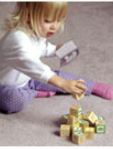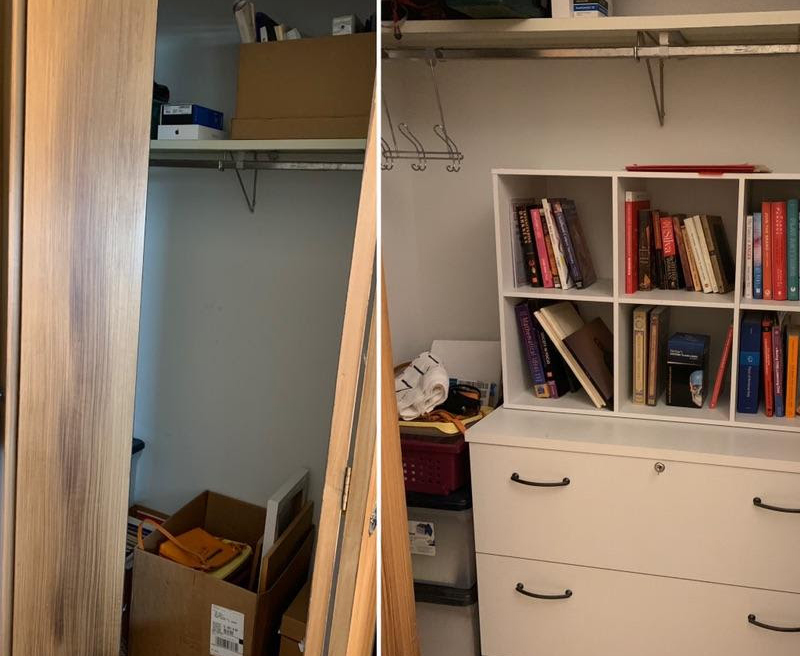Security, Cleaning, and Organizing – Yes, They Go Together
Organization is calming to the senses, literally.
What’s with all the cleaning and organizing? Did Marie Kondo drop a new show?
The organizing bug finally got me. I’d avoided the big closet organizing project in my home office for over a year. I even explained to a friend via photos to show why it was complicated, thus overwhelming. Sound familiar?
To get started, I needed a plan, so I sat down and wrote out each step required. A week later I followed the plan — the hardest step was starting. Now, the project is mostly done.(See above before/after photo.)
The organized space seems to have freed space in my mind too!
Stay at Home = Need to Organize = Security?
Yes, it turns out that bringing order to our external environment helps us feel calmer and more secure.
When the environment is orderly, it is easier for our sensory systems to scan and determine if something is a threat. This supports our sense of security and calm.
Marie Kondo’s KonMari approach to organizing became a pop phenomenon last year. Below I discuss how the simple structure of her method fundamentally supports security.
As children, we learn to organize our surroundings as our sensory-motor skills evolve. The skill for this is ‘sorting’. Below I share how the task of sorting relates to security, and, ultimately, executive function.
Internal re-organization = inner calm?
Organizing your environment isn’t the only calming option. Internal organization is another aspect of feeling secure because it allows your sensory systems to efficiently tell your brain you are safe.
For a basic level of re-organization you can do on your own, we’ve shared a breathing exercise and rocking movements in our recent newsletters.
Bridging® = Inner Organization
One of the objectives of the Bridging process is to actually restore your internal organization. The technique provides the boundaries and gentle movement support to guide the body to re-organize. This is at a deeper level than you can do on your own. Clients always comment on how calm they feel after a Bridging session.
In general, we feel calmer and more secure when our internal and external worlds are organized.
Need help with some calm and focus, pain or balance? You can schedule a virtual Zoom consult by e-mailing Cara. New and existing clients are welcome to use this option.
Why is the KonMari® approach so appealing?
(KonMari® is a Japanese home organizing process created by Marie Kondo, who also has a popular show on Netflix.)

The appeal to the KonMari approach is its simplicity comprised of boundaries, supports, and limits. All are basic elements to our feeling secure.
Marie’s process provides:
- Structural support via the instructions: Take everything out of a closet, dresser, or cabinet.
- Limited choices: Each item has to be put into one of three piles — keep, toss, donate.
- Boundaries to the scope: A given timeline for completion of each step keeps procrastinators on track.
Not only did the people on her shows have to make the decisions, they learned the skills needed to maintain the process going forward. She took people back to the basic elements of how we learn, as children, to sort and organize.
The Developmental Root of Organizing
 The developmental root of organizing is the task of sorting.
The developmental root of organizing is the task of sorting.
Sorting is a visual-motor skill which begins with matching pairs. The next step is figuring out basic three-part relationships such as small, medium, large, and then creating small groupings. Sorting is a fundamental building block of executive function.
What is required to facilitate sorting or organizing?
Start by establishing basic boundaries or guidelines, along with some options offered as support. Limits are also useful to keep from being overwhelmed.
My office project was overwhelming until I broke it into little steps. Support is often in the form of help to create steps to the process. Friends, teachers, family member,s or professionals are resources for providing boundaries and some guidance.
Examples of boundaries are time limits or number of attempts.
- What can you figure out in 3 minutes?
- Try it three times and then I’ll help.
Examples of limits generally are related to safety.
- You can stack the blocks but not on the stairs.
- You can sort the books but let me get the ones from the top shelf.
Examples of supports are providing choices to narrow the variables, or showing an example.
- Try using this one or that one. What happens with each one?
- Here is one way you can do it. Can you think of another?
For Parents- Sorting
If you want to explore organizing with your child, this short video shows several phases of the learning process.
This includes exploration of the various shape attributes, and then devising different ways to group them. Enjoy!

